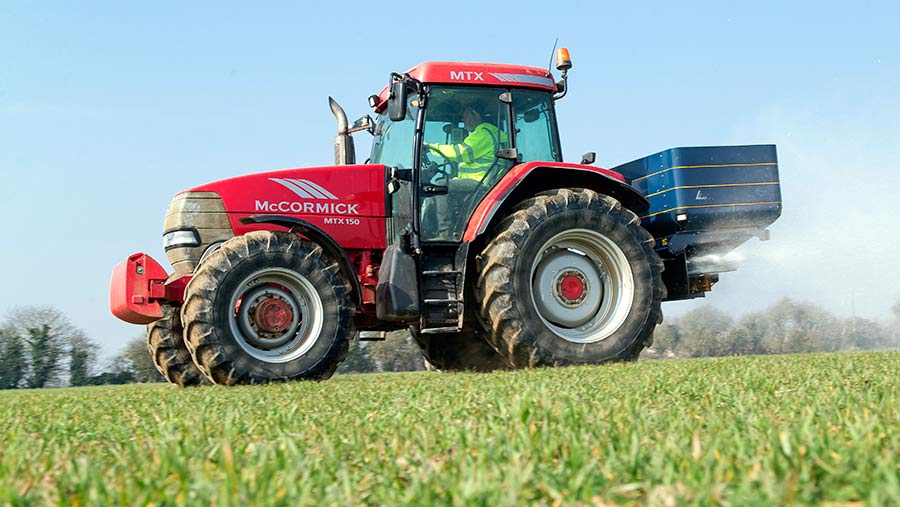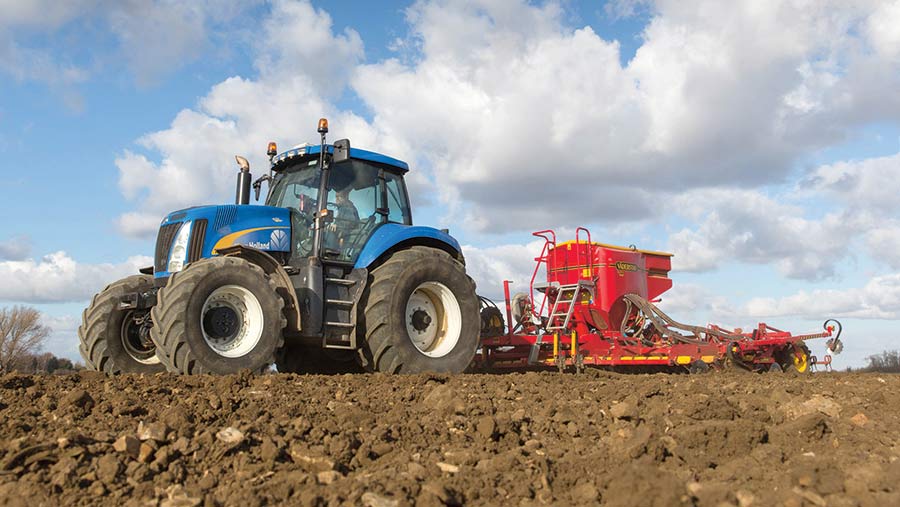Crop Watch: Hungry crops get first spring fertiliser dose
 Spreading fertiliser © Gary Naylor
Spreading fertiliser © Gary Naylor Many crops are receiving their first fertiliser dressing of the season to kick start growth and build up canopies.
Fears of last year have prompted farmers to get fertiliser on rather than risk not being able to get on fields later.
However, Sean Sparling highlights that some of the highest nitrogen losses come from applications made too early and in the wrong conditions.
Disease is also being reported by our agronomists, including light leaf spot in oilseed rape and septoria in wheat.
See also: Analysis: What a ban on fungicide chlorothalonil would mean
However, as Stephen Harrison points out, there is no need to panic as the disease is on overwintered leaves and can be contained with robust fungicide programmes.
South: Iain Richards

Ian Richardson
Agrii (Oxfordshire)
Nutrition is our top priority as crops begin to emerge from the winter, especially with the levels of flea beetle larvae in our oilseed rape and last season’s cold, wet spring fresh in our minds.
We’re not expecting another Beast from the East, but wherever we missed the chance of getting nitrogen on early last year we struggled to do so until well into April – and our crops struggled as a result. We don’t want to run this risk again.
The mild and dry winter so far means most of our winter cereals are well-rooted. Even the later-drilled wheats on bad blackgrass ground are noticeably better-tillered than last season.
While it took plenty of nerve to hold off on drilling here until we got a good pre-planting flush of weed growth to spray off, it really paid dividends.
With decent seed-beds, just the right amount of moisture and cooler conditions giving us excellent pre- and peri-emergence activity, we’ve seen very good blackgrass control as well as crop development.
Oilseed rape
Although they may be carrying the highest burdens of flea beetle we’ve ever seen, most of our OSR crops are well-rooted with good basal stem reserves too – which is what really matters.
We know the vigorous, fast-developing varieties we prioritise are particularly good at compensating for larval damage. But we also know we have to help them do this with the best possible spring management.
As soon as conditions allow, we’ll be giving our rape 50-60kg N/ha as the first step in a little-and-often programme of canopy building.
With green area indices well below 1.0 in most cases, we certainly aren’t planning any early growth regulation.
Instead, wherever it’s needed we’ll be using prothioconazole at stem extension to keep any light leaf spot firmly in check, accompanied by molybdenum, boron and magnesium that tissue testing is already showing we need.
We’re also redoubling our pigeon-control efforts, as the last thing larvae-infested crops need is even more leaf loss.
Within the next two weeks, we’re also aiming to give our second wheats, winter barleys and later-sown first wheats a good 70kg/ha of N, well ahead of our very well-tillered earlier October sowings on low blackgrass-risk ground.
The relative climatic calm of the past week has allowed us to finish spraying off our cover crops, giving us the four-week window we want ahead of spring drilling where blackgrass management is the priority.
It may give us higher yields, but we deliberately avoid early spring cereal drilling here.
In contrast, where blackgrass is less of an issue and we don’t have cover crops to destroy, we’re making a determined start on spring barley drilling.
Ground set up traditionally in the autumn has weathered down nicely to give us just the sort of seed-beds we like, with minimal working to wake up weeds or waste precious soil moisture.
West: Stephen Harrison

Stephen Harrison
AICC/Southwest Agronomy (Avon)
Spring must be coming! Snowdrops are out, daffodils are budding, and my first Crop Watch is under way.
Crops have responded to the warmer temperatures of late and winter barley and rape are receiving their first nitrogen and sulphur.
Wheat can wait for a few more weeks, most of it won’t see the spreader until mid-March.
Second wheats and thinner zero-tilled crops will get 40 or 50kg/ha of N once the rape and barley have been taken care of.
Cabbage stem flea beetle larvae continue their relentless progress and they have come through the cold snap relatively unscathed.
Be prepared for some strange looking OSR crops once spring growth starts in earnest. Feeding larvae will play havoc with the plant’s hormones.
Light leaf spot is now being detected in crops that received no autumn fungicide and are due for prothioconazole.
Septoria lurking
Septoria is detectable in over-wintered rosette leaves in winter wheat, however there is absolutely no need to panic. These leaves are not yield-forming and, thankfully, robust programmes are still able to contain the disease.
While some SDHI/azole mixes have demonstrated better control as single treatments, there is little to choose between the best materials in programmes that include chlorothalonil.
We await with bated breath the results of the review of this crucial fungicide. I fear that while septoria control may be possible with upcoming materials, it will be at a much greater cost.
The social media attack on our industry continues. Uninformed comments about breeders producing varieties that only yield under conditions of maximum input use are misleading or blatantly wrong.
Simply look at advances in wheat blossom midge resistance, vastly improved septoria resistance or barley yellow dwarf virus tolerant winter barley to see what is really happening.
Do these people really think that arable farmers spend their working lives driving around fields with sprayers full of expensive agrochemicals ready to blast anything that moves?
Integrated crop management has been practised for years, it is how I have always done my job and must be the reality, not an aspiration.
North: Andy Goulding

Andy Goulding
Hutchinsons (Cheshire/North Wales)
Few of my clients can remember a time when crops have looked so good at this time of year.
Of course there is the exception other crop watchers have mentioned, yellowing barleys where the larger canopies are running out of nutrition with a bit of mildew kicking around as well.
It’s a very positive position to be in, crops are good and prices should, hopefully, remain strong come harvest and we can travel at this time of year to treat crops. A first for me!
Growth has been almost continual all winter as my turf crops that failed to root well in the summer drought are now holding together and being harvested. This goes to show just how much growth there has been.
At present all high biomass cereals, second wheats and oilseed rape should have received nitrogen and sulphur and those less forward are destined to do so.
Micro-nutrients

Spring barley drilling © Tim Scrivener
Hopefully, at the time of print I would have received all the tissue analysis results back to treat crops with micro-nutrition where appropriate.
Manganese has been an issue in many areas, particularly light land and those not rolled. This is being addressed, but remember sub-clinical deficiencies, not just those shouting loudly.
The earlier we can get a healthy, well-nourished, well-rooted, big canopy the better the chance we have of high yield.
Some very forward and tall crops will also be getting plant growth regulators to get some order back into the canopy.
As I say, it’s good to get a large canopy intercepting plenty of light early, but the capacity of the roots to feed it season-long is essential.
Winter oats are looking good after heeding lessons from others and not opting for the use of flufenacet. Thus far, I’m pleased with the weed burden remaining given the lack of residual chemistry available.
Septoria in wheat is a bit of mixed bag, some are as clean as a whistle whilst others are harbouring plenty of it.
Hopefully, as this is published spring cereals are being drilled as soils are becoming friable again, with only the problem areas where severe compaction or drainage is an issue.
Remember to always drill plant numbers not weight and to be realistic with establishment. Don’t fall at the first hurdle.
East: Sean Sparling

Sean Sparling
AICC/SAS Agronomy (Lincolnshire)
January saw 17.8 mm of rain and we’ve just had 14.2 mm so far in February – the driest start to a year I have recorded in 25 years.
Oilseed rape is clearly a tale of two crops, with those less affected by cabbage stem flea beetle adults last autumn looking well, apart from being hammered by pigeons over the last few weeks.
Then there are those that suffered significant flea beetle damage now revealing the extent of the larval infestation. We may well yet lose more, as these latter crops try to grow away.
Disease levels remain very low although increasing temperatures may change things. With only three weeks’ protection from even the best fungicides on light leaf spot, timing will be crucial.
First applications of nitrogen plus sulphur are being applied where soil and crop conditions allow.
Spring barley
About 70% of my 1,900 ha of spring barley is in the ground – yet to emerge but in the ground nonetheless – and, as conditions allow, spring beans are going in too.
However, for spring cereals that are being drilled as part of a blackgrass control strategy, these fields are being delayed in order to achieve a further flush prior to drilling. Pre-emergence herbicides will follow tight behind the drill.
Winter wheat looks generally green and pleasant so first nitrogen won’t go on for a couple of weeks yet, unless soil temperatures increase from their current 4.2C and the crop gets growing enough to be capable of grabbing hold of it.
With day temperatures in the low teens, soils will soon mineralise and release nitrogen, therefore, reducing the need for us to go charging in on cereals.
Our greatest nitrogen losses come from applications made too early and in the wrong conditions, so letting the soils warm, mineralise and supply the crop from the labile pool makes more sense at present unless fields are clearly struggling. Blackgrass levels are generally unnervingly low.
Winter barley looks as gold as a guinea.
With such a dry start to 2019 following a 2018 reminiscent of 1975, I sincerely hope we are not staring down the barrels of another 1976 – only time will tell.

